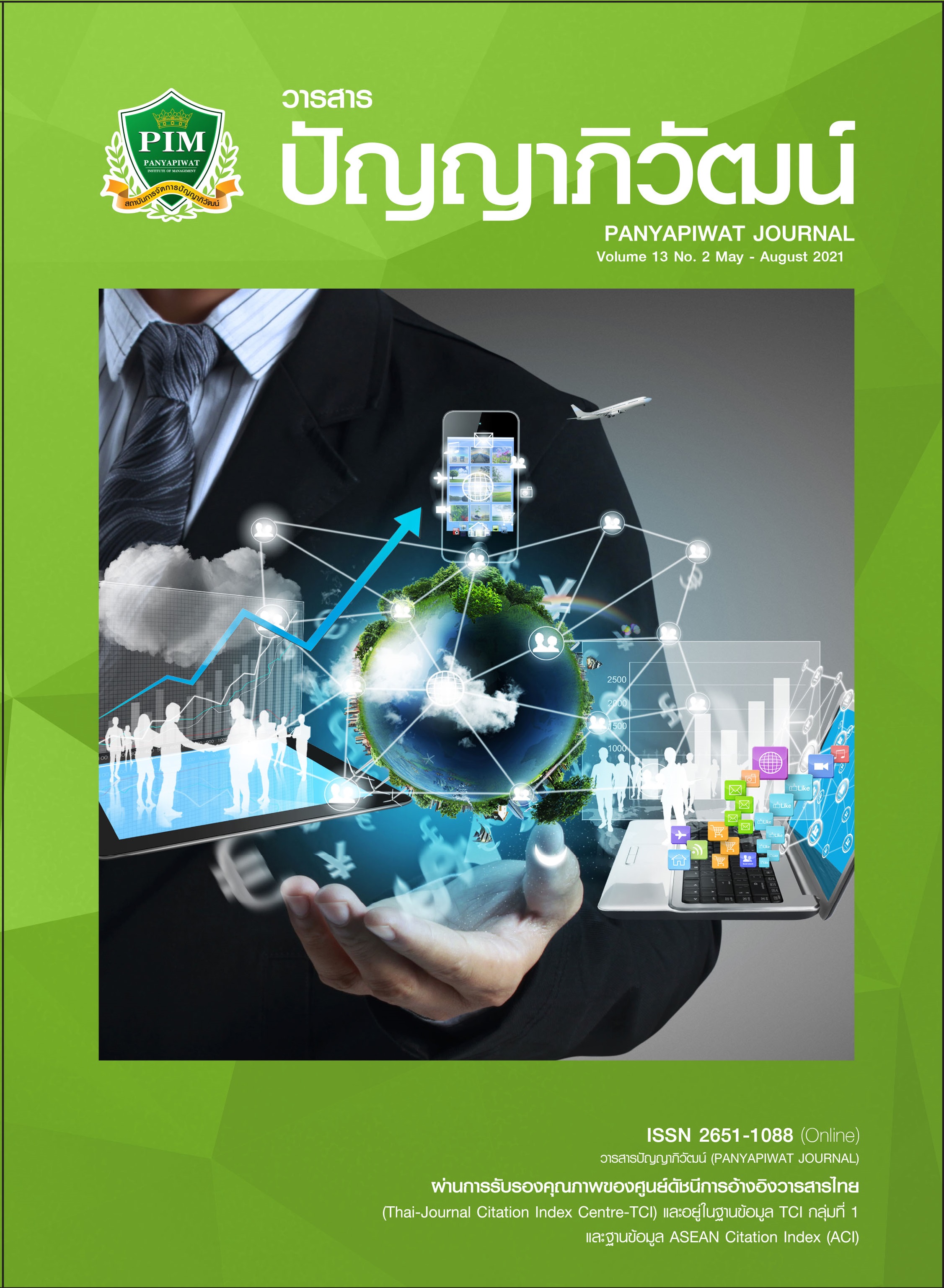แนวทางการสร้างความได้เปรียบทางการแข่งขันสำหรับคลัสเตอร์อุตสาหกรรมอาหารแปรรูป
Main Article Content
บทคัดย่อ
งานวิจัยนี้มีวัตถุประสงค์เพื่อ 1) ศึกษาแนวทางการสร้างความได้เปรียบทางการแข่งขันสำหรับ คลัสเตอร์อุตสาหกรรมอาหารแปรรูป 2) พัฒนาแบบจำลองสมการโครงสร้างแนวทางการสร้างความได้เปรียบทางการแข่งขันสำหรับคลัสเตอร์อุตสาหกรรมอาหารแปรรูปตามสมมติฐานกับข้อมูลเชิงประจักษ์ โดยใช้กลุ่มตัวอย่างที่เป็นผู้ประกอบการในธุรกิจอาหารแปรรูปที่ใช้วัตถุดิบในการผลิตจากพืช และผู้ประกอบการที่ใช้วัตถุดิบในการผลิตจากสัตว์ในเขตกรุงเทพและปริมณฑลจำนวน 500 ราย โดยใช้แบบสอบถาม สุ่มตัวอย่างแบบแบ่งกลุ่ม กำหนดตัวอย่างแต่ละกลุ่มร้อยละ 50 วิเคราะห์ข้อมูลโดยใช้เทคนิคการวิเคราะห์แบบจำลองสมการโครงสร้าง โดยข้อมูลทั่วไปของผู้ประกอบการพบว่า ธุรกิจส่วนใหญ่เปิดดำเนินการอยู่ในช่วง 7-15 ปี มีบุคลากรตั้งแต่ 50 คน ส่วนใหญ่เป็นสมาชิกของสภาอุตสาหกรรมแห่งประเทศไทย และประกอบการในรูปบริษัทจำกัด
ผลการวิจัยพบว่า แนวทางการสร้างความได้เปรียบทางการแข่งขันสำหรับคลัสเตอร์อุตสาหกรรมอาหารแปรรูปประกอบด้วย 4 องค์ประกอบ โดยองค์ประกอบด้านการสร้างความร่วมมือมีความสำคัญมากที่สุดรองลงมาได้แก่ องค์ประกอบด้านการสร้างนวัตกรรม องค์ประกอบด้านเทคโนโลยีสารสนเทศ และองค์ประกอบด้านการปรับตัวขององค์กรตามลำดับ ผลการศึกษาระดับความสำคัญเป็นรายข้อพบว่า รายข้อที่มีความสำคัญสูงที่สุด ได้แก่ การที่สมาชิกกลุ่มต้องเข้าร่วมประชุมกับสมาชิกในเครือข่ายความร่วมมือเพื่อร่วมกันกำหนดวิสัยทัศน์ และพันธกิจ การส่งอิทธิพลในรายองค์ประกอบพบว่า องค์ประกอบด้านการสร้างความร่วมมือส่งอิทธิพลทางตรงต่อองค์ประกอบด้านเทคโนโลยีสารสนเทศมากที่สุดที่นํ้าหนัก 0.82 ส่วนผลการทดสอบความแตกต่างของระดับความสำคัญของแนวทางการสร้างความได้เปรียบทางการแข่งขันพบว่า ผู้ประกอบการที่ใช้วัตถุดิบในการผลิตจากพืช และผู้ประกอบการที่ใช้วัตถุดิบในการผลิตจากสัตว์ด้วยการทดสอบค่าที (t-test)ให้ความสำคัญกับ แนวทางการสร้างความได้เปรียบทางการแข่งขันสำหรับคลัสเตอร์อุตสาหกรรมอาหารแปรรูปในภาพรวมไม่แตกต่างกัน ผลการวิเคราะห์ตัวแบบจำลองสมการโครงสร้างที่ได้พัฒนาขึ้นพบว่า ผ่านตามเกณฑ์การประเมิน มีความสอดคล้องกลมกลืนกับข้อมูลเชิงประจักษ์ โดยมีระดับความน่าจะเป็นของไคสแควร์ เท่ากับ .088 ค่าไคสแควร์สัมพัทธ์ เท่ากับ 1.137 ค่าดัชนีวัดระดับความสอดคล้อง เท่ากับ .961 และค่าดัชนีรากของค่าเฉลี่ยกำลังสองของการประมาณค่าความคลาดเคลื่อน เท่ากับ .016
Article Details
“ข้าพเจ้าและผู้เขียนร่วม (ถ้ามี) ขอรับรองว่า บทความที่เสนอมานี้ยังไม่เคยได้รับการตีพิมพ์และไม่ได้อยู่ระหว่างกระบวนการพิจารณาลงตีพิมพ์ในวารสารหรือแหล่งเผยแพร่อื่นใด ข้าพเจ้าและผู้เขียนร่วมยอมรับหลักเกณฑ์การพิจารณาต้นฉบับ ทั้งยินยอมให้กองบรรณาธิการมีสิทธิ์พิจารณาและตรวจแก้ต้นฉบับได้ตามที่เห็นสมควร พร้อมนี้ขอมอบลิขสิทธิ์บทความที่ได้รับการตีพิมพ์ให้แก่สถาบันการจัดการปัญญาภิวัฒน์หากมีการฟ้องร้องเรื่องการละเมิดลิขสิทธิ์เกี่ยวกับภาพ กราฟ ข้อความส่วนใดส่วนหนึ่งและ/หรือข้อคิดเห็นที่ปรากฏในบทความข้าพเจ้าและผู้เขียนร่วมยินยอมรับผิดชอบแต่เพียงฝ่ายเดียว”
เอกสารอ้างอิง
Aferdita, D. S. (2015). The Impact of Information Technology in Decision Making Process of Companies in Kosovo. Informatologia, 51(1-2), 13-23.
Aujiraphongpan, S. (2016). The Network-Based Capability and Innovative Capabilities of SMEs. Executive Journal, 36(2), 1-10.
Bank of Thailand. (2018). Dissemination Information. Retrieved January 12, 2019, from https://www.bot.or.th
Berisha, M. (2015). The Role of Information Technology in Small and Medium Sized Enterprises in Kosovo. Fullbright Academy Conference (pp. 1-9). Kosovo: Pristina Printing.
Bessant, J. & Tidd, J. (2015). Managing Innovation and Entrepreneurship. Italy: Trento Srl.
Boonsuk, A. (2012). Political Communication on Energy Resources in the Gulf of Thailand. Doctoral Dissertation, Krirk University. [in Thai]
Cecilia, L. (2018). Benefit of IT and Influence to Business Collaboration. Retrieved August 5, 2017, from https://bsc.dip.go.th/th/category/salemarketing/sm-
Chulalongkorn University Intellectual Property Institute. (2017). Industry and Technology Trend Analysis Report. Bangkok: Chulalongkorn University. [in Thai]
Department of Industrial Promotion. (2017). Food Industry Report. Retrieved August 18, 2017, from https://www.dip.go.th/th/news/category/09-48-26 [in Thai]
Deutsch, W. K. (1993). The Nerves of Government: Model of Communication and Control. New York: Free Press.
Everett, R. (1995). Diffusion of Innovations Theory. Retrieved August 31, 2017, from http://fic.nfi.or.th/fooddirectory/bussfood.php
Food Industry Outlook. (2018). Global Food Industry Report. Retrieved August 15, 2017, from https://www.boi.go.th/upload/content/Food%20industry_5abde0169bf4c.pdf [in Thai]
Food Intelligent Center Thailand. (2018). The Food Industrial Sector: Product Classification. Retrieved August 31, 2017, from http://fic.nfi.or.th/fooddirectory/bussfood.php [in Thai]
Food Network Solution. (2015). SMEs Knowledge Center. Retrieved August 18, 2017, from http://www.onartgroup.com/Article/0233.pdf [in Thai]
Gunasekare, K. (2015). Catalyzing Development through ICT Adoption. Switzerland: Springer International Publishing.
Haythornthwaite, C. (1996). Social Network Analysis: An Approach and Techniques for Study of Information. Exchange. Library & Information Science Research, 18(4), 323-342.
Juathai, P. (2014). Analysis of Thai Industrial Cluster. Master of Engineering Program, Chulalongkorn University. [in Thai]
Junkrapor, M. & Chienwattanasook, K. (2019). Establishing an Innovative Organization to Drive towards the Organizational Excellence. Executive Journal, 39(1), 1-15.
Kiandokht, H. (2015). Relationship between Technology and Marketing. Journal of Information Technology Management, 3(8), 1-4.
Luke, P. (2004). Networking and Innovation: A Systematic Review of the Evidence. International Journal of Management Reviews, 5(3-4), 137-168.
Luke, P., Maxine, R., Kamal, M., & Denyer, D. (2015). Networking and Innovation: A Systematic Review of the Evidence. Washington, D.C.: Ohio University.
Lundvall, B. A., Johnson, B., Andersen, E. S., & Dalum, B. (2002). National Systems Production, Innovation & Competence Building. Research Policy, 31, 213-231.
Naipinit, A., Kroeksakul, P., & Promsaka Na Sakolnakorn, T. (2014). Adjustment UnderGlobalization. SKRU Academic Journal, 7(1), 1-12.
National Food Institute. (2018). Food Statistics Report. Retrieved August 15, 2017, from https://sites.google.com/site/thaiandland/Home/sitemap/ads-with-thaiandland-1/national-food-institute [in Thai]
Nieves, J., Quintana, A., & Osorio, J. (2015). Organization Knowledge, Dynamic Capabilities and innovation in the Industry. Retrieved August 15, 2017, from http://hdl.handle.net/105053
Per, L., Holmstrom, J., & Mathiassen, L. (2017). Managing Research and Innovation. Network Research Policy, 43(1), 156-168.
Poolpatarachewin, T. (2010). Creative Economy. Retrieved August 18, 2017, from http://sites.Google.com/site/gaiusjustthink/thitikorn-on-design/naewthangnikarkhablehelkicrrkh
Porter, M. E. (1990). The Competitive Advantage of Nations. Harvard Business Review, 1(1), 1-21.
Punnongwa, W. & Wadchalarak, R. (2014). Germinated Brown Rice and Cereal Mixed Produced (Research Report). Surin: Rajamangala University of Technology Isan. [in Thai]
Rehman, N. (2017). A Complementary Relationship between Networks and Organizational Innovation Activities: Evidence from Chile. Journal of Innovation Economics. De Boeck University, 6(2), 83-106.
Rotchanakitumnuai, S. (2013). The Application of Information Technology and the Advancement of Electronic Tourism. Chulalongkorn Business Review, 35(3), 137. [in Thai]
Sakhonkaruhatdej, K. (2016). Dynamic Capability and Competitive Advantage with the Success of Thailand’s Processed Food Industry. Kasen Bundit Journal, 17(2), 1-14. [in Thai]
Sakratanuamporn, P. (2015). A Study of Competitiveness on Export of Computer Equipment and Components from Thailand. Master of Economics, Kasetsart University. [in Thai]
Silcharu, T. (2020). Research and Statistical Analysis by SPSS and AMOS (18th ed.). Bangkok: Partnership R&D Printing. [in Thai]
Sittichai, K. & Phuripakdee, S. (2018). Organization Management According to McKinsey’s Framework that Contributes to Organization Case Study: Organization Awarded and Excellent Innovation. Veridian E-Journal, Silpakorn University, 11(3), 23-50. [in Thai]
Solomon, G. T., Bryant, A., May, K., & Perry, V. (2013). Survival of Fittest: Technical Assistance, Survival and Growth of Small Business and Implications for Public Policy. Technovation Journal, 33(8-9), 292-301.
Sutthinipapun, D. (2014). Community Enterprise Development in the 5 Southern Border Province. Bangkok: Office of Competitiveness Development. [in Thai]
Teece, D. J. (2007). Explicating Dynamic Capabilities: The Nature and Micro-Foundations of Enterprise Performance Strategic. Management Journal, 28(1), 1319-1350.


